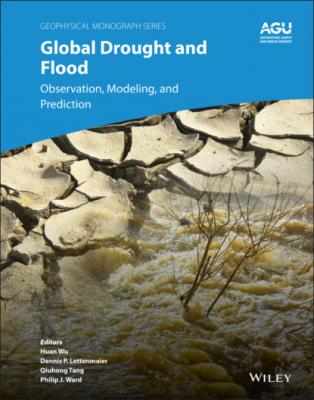Global Drought and Flood. Группа авторов
Читать онлайн.| Название | Global Drought and Flood |
|---|---|
| Автор произведения | Группа авторов |
| Жанр | География |
| Серия | |
| Издательство | География |
| Год выпуска | 0 |
| isbn | 9781119427216 |
110 Ma, M., Ren, L., Yuan, F., Jiang, S., Liu, Y., Kong, H., & Gong, L. (2014). A new standardized Palmer drought index for hydro‐meteorological use. Hydrological Processes, 28(23), 5645–5661. https://doi.org/10.1002/hyp.10063
111 Madadgar, S., & Moradkhani, H. (2014). Spatio‐temporal drought forecasting within Bayesian networks. Journal of Hydrology, 512, 134–146. https://doi.org/10.1016/j.jhydrol.2014.02.039
112 Madani, K., AghaKouchak, A., & Mirchi, A. (2016). Iran’s socio‐economic drought: challenges of a water‐bankrupt nation. Iranian Studies, 49(6), 997–1016.
113 Mallakpour, I., Sadegh, M., & AghaKouchak, A. (2018). A new normal for streamflow in California in a warming climate: Wetter wet seasons and drier dry seasons. Journal of Hydrology, 567, 203–211.
114 Margulis, S.A., Cortés, G., Girotto, M., & Durand, M. (2016). A Landsat‐era Sierra Nevada snow reanalysis (1985–2015). Journal of Hydrometeorology, 17, 1203–1221. https://doi.org/10.1175/JHM‐D‐15‐0177
115 Margulis, S.A., Wood, E.F., & Troch, P.A. (2006). The terrestrial water cycle: Modeling and data assimilation across catchment scales. Journal of Hydrometeorology, 7(3), 309–311.
116 Martínez‐Fernández, J., González‐Zamora, A., Sánchez, N., Gumuzzio, A., & Herrero‐Jiménez, C.M. (2016). Satellite soil moisture for agricultural drought monitoring: Assessment of the SMOS derived Soil Water Deficit Index. Remote Sensing of Environment, 177, 277–286.
117 Massari, C., Brocca, L., Tarpanelli, A., & Moramarco, T. (2015) Data assimilation of satellite soil moisture into rainfall‐runoff modelling: A complex recipe?. Remote Sensing, 7(9), 11403–11433.
118 Mateus, P., Borma, L. S., da Silva, R. D., Nico, G., & Catalão, J. (2016). Assessment of two techniques to merge ground‐based and TRMM rainfall measurements: a case study about Brazilian Amazon Rainforest. GIScience and Remote Sensing, 53(6), 689–706.
119 Mazdiyasni, O., & AghaKouchak, A. (2015). Substantial increase in concurrent droughts and heatwaves in the United States. Proceedings of the National Academy of Sciences, 112(37), 11484–11489.
120 Mckee, T.B., Doesken, N.J., & Kleist, J. (1993). The relationship of drought frequency and duration to time scales. American Meteorological Society 8th Conference on Applied Climatology (January, pp. 179–184). https://doi.org/citeulike‐article‐id:10490403
121 McQuigg, J. (1954). A simple index of drought conditions. Weatherwise, 7(3), 64–67.
122 McVicar, T.R., Roderick, M.L., Donohue, R.J., Li, L.T., Van Niel, T.G., Thomas, A., et al. (2012). Global review and synthesis of trends in observed terrestrial near‐surface wind speeds: Implications for evaporation. Journal of Hydrology, 416, 182–205.
123 Mehran, A., AghaKouchak, A., & Phillips, T.J. (2014). Evaluation of CMIP5 continental precipitation simulations relative to satellite‐based gauge‐adjusted observations. Journal of Geophysical Research: Atmospheres, 119(4), 1695–1707.
124 Meng, J., Li, L., Hao, Z., Wang, J., & Shao, Q. (2014). Suitability of TRMM satellite rainfall in driving a distributed hydrological model in the source region of Yellow River. Journal of Hydrology. 509, 320–332. https://doi.org/10.1016/j.jhydrol.2013.11.049
125 Merlin, O., Malbéteau, Y., Notfi, Y., Bacon, S., Khabba, S.E.‐R. S., & Jarlan, L. (2015). Performance metrics for soil moisture downscaling methods: Application to DISPATCH data in central Morocco. Remote Sensing, 7(4), 3783–3807.
126 Miralles, D.G., Teuling, A.J., Van Heerwaarden, C.C., & De Arellano, J.V.G. (2014). Mega‐heatwave temperatures due to combined soil desiccation and atmospheric heat accumulation. Nature Geoscience, 7(5), 345–349. https://doi.org/10.1038/ngeo2141
127 Mishra, A.K., & Singh, V.P. (2010). A review of drought concepts. Journal of Hydrology, 391(1–2), 202–216. https://doi.org/10.1016/j.jhydrol.2010.07.012
128 Mishra, A., Vu, T., Veettil, A. V., & Entekhabi, D. (2017). Drought monitoring with soil moisture active passive (SMAP) measurements. Journal of Hydrology, 552, 620–632.
129 Mladenova, I.E., Bolten, J.D., Crow, W.T., Sazib, N., Cosh, M.H., Tucker, C.J., & Reynolds, C. (2019). Evaluating the operational application of SMAP for global agricultural drought monitoring. IEEE Journal of Selected Topics in Applied Earth Observations and Remote Sensing, 12(9), 3387–3397.
130 Mo, K. C., & Lettenmaier, D. P. (2015). Heat wave flash droughts in decline. Geophysical Research Letters, 42(8), 2823–2829.
131 Modaresi Rad, A., & Khalili, D. (2015). Appropriateness of clustered raingauge stations for spatio‐temporal meteorological drought applications. Water Resources Management, 29(11). https://doi.org/10.1007/s11269‐015‐1051‐6
132 Modaresi Rad, A., Ghahraman, B., Khalili, D., Ghahremani, Z., & Ardakani, S.A. (2017). Integrated meteorological and hydrological drought model: A management tool for proactive water resources planning of semi‐arid regions. Advances in Water Resources, 107, 336–353. https://doi.org/10.1016/j.advwatres.2017.07.007
133 Modaresi Rad, A., Khalili, D., Kamgar‐Haghighi, A.A., Zand‐Parsa, S., & Banimahd, S.A. (2016). Assessment of seasonal characteristics of streamflow droughts under semiarid conditions. Natural Hazards, 82(3). https://doi.org/10.1007/s11069‐016‐2256‐6
134 Moftakhari, H.R., AghaKouchak, A., Sanders, B.F., & Matthew, R.A. (2017). Cumulative hazard: The case of nuisance flooding. Earth’s Future, 5(2), 214–223.
135 Mohanty, S., Jha, M.K., Raul, S.K., Panda, R.K., & Sudheer, K.P. (2015). Using artificial neural network approach for simultaneous forecasting of weekly groundwater levels at multiple sites. Water Resources Management, 29(15), 5521–5532.
136 Moradi, I., Arkin, P., Ferraro, R., Eriksson, P., & Fetzer, E. (2016). Diurnal variation of tropospheric relative humidity in tropical regions. Atmospheric Chemistry and Physics, 16, 6913–6929. https://doi.org/10.5194/acp‐16‐6913‐2016
137 Moradkhani, H. (2008). Hydrologic remote sensing and land surface data assimilation. Sensors, 8(5), 2986–3004.
138 Moran, M.S., Clarke, T.R., Inoue, Y., & Vidal, A. (1994). Estimating crop water deficit using the relation between surface‐air temperature and spectral vegetation index. Remote Sensing of Environment, 49(3), 246–263.
139 Mote, P.W., Rupp, D.E., Li, S., Sharp, D.J., Otto, F., Uhe, P.F., et al. (2016). Perspectives on the causes of exceptionally low 2015 snowpack in the western United States. Geophysical Research Letters, 43(20), 10–980. https://doi.org/10.1002/2016GL069965
140 Mu, Q., Zhao, M., Kimball, J.S., McDowell, N.G., & Running, S.W. (2013). A remotely sensed global terrestrial drought severity index. Bulletin of the American Meteorological Society, 94(1), 83–98.
141 Mueller, B., & Seneviratne, S.I. (2012). Hot days induced by precipitation deficits at the global scale. Proceedings of the National Academy of Sciences, 109(31), 12398–12403. https://doi.org/10.1073/pnas.1204330109
142 Narasimhan,
